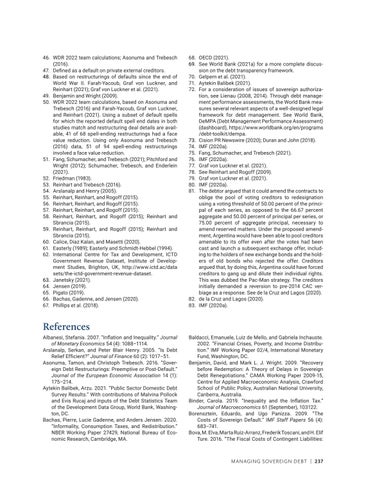46. WDR 2022 team calculations; Asonuma and Trebesch (2016). 47. Defined as a default on private external creditors. 48. Based on restructurings of defaults since the end of World War II. Farah-Yacoub, Graf von Luckner, and Reinhart (2021); Graf von Luckner et al. (2021). 49. Benjamin and Wright (2009). 50. WDR 2022 team calculations, based on Asonuma and Trebesch (2016) and Farah-Yacoub, Graf von Luckner, and Reinhart (2021). Using a subset of default spells for which the reported default spell end dates in both studies match and restructuring deal details are available, 41 of 68 spell-ending restructurings had a face value reduction. Using only Asonuma and Trebesch (2016) data, 51 of 94 spell-ending restructurings involved a face value reduction. 51. Fang, Schumacher, and Trebesch (2021); Pitchford and Wright (2012); Schumacher, Trebesch, and Enderlein (2021). 52. Friedman (1983). 53. Reinhart and Trebesch (2016). 54. Arslanalp and Henry (2005). 55. Reinhart, Reinhart, and Rogoff (2015). 56. Reinhart, Reinhart, and Rogoff (2015). 57. Reinhart, Reinhart, and Rogoff (2015). 58. Reinhart, Reinhart, and Rogoff (2015); Reinhart and Sbrancia (2015). 59. Reinhart, Reinhart, and Rogoff (2015); Reinhart and Sbrancia (2015). 60. Calice, Diaz Kalan, and Masetti (2020). 61. Easterly (1989); Easterly and Schmidt-Hebbel (1994). 62. International Centre for Tax and Development, ICTD Government Revenue Dataset, Institute of Development Studies, Brighton, UK, http://www.ictd.ac/data sets/the-ictd-government-revenue-dataset. 63. Janetsky (2021). 64. Jensen (2019). 65. Pigato (2019). 66. Bachas, Gadenne, and Jensen (2020). 67. Phillips et al. (2018).
68. OECD (2021). 69. See World Bank (2021a) for a more complete discussion on the debt transparency framework. 70. Gelpern et al. (2021). 71. Aytekin Balibek (2021). 72. For a consideration of issues of sovereign authorization, see Lienau (2008, 2014). Through debt management performance assessments, the World Bank measures several relevant aspects of a well-designed legal framework for debt management. See World Bank, DeMPA (Debt Management Performance Assessment) (dashboard), https://www.worldbank.org/en/programs /debt-toolkit/dempa. 73. Cision PR Newswire (2020); Duran and John (2018). 74. IMF (2020a). 75. Fang, Schumacher, and Trebesch (2021). 76. IMF (2020a). 77. Graf von Luckner et al. (2021). 78. See Reinhart and Rogoff (2009). 79. Graf von Luckner et al. (2021). 80. IMF (2020a). 81. The debtor argued that it could amend the contracts to oblige the pool of voting creditors to redesignation using a voting threshold of 50.00 percent of the principal of each series, as opposed to the 66.67 percent aggregate and 50.00 percent of principal per series, or 75.00 percent of aggregate principal, necessary to amend reserved matters. Under the proposed amendment, Argentina would have been able to pool creditors amenable to its offer even after the votes had been cast and launch a subsequent exchange offer, including to the holders of new exchange bonds and the holders of old bonds who rejected the offer. Creditors argued that, by doing this, Argentina could have forced creditors to gang up and dilute their individual rights. This was dubbed the Pac-Man strategy. The creditors initially demanded a reversion to pre-2014 CAC verbiage as a response. See de la Cruz and Lagos (2020). 82. de la Cruz and Lagos (2020). 83. IMF (2020a).
References Albanesi, Stefania. 2007. “Inflation and Inequality.” Journal of Monetary Economics 54 (4): 1088–1114. Arslanalp, Serkan, and Peter Blair Henry. 2005. “Is Debt Relief Efficient?” Journal of Finance 60 (2): 1017–51. Asonuma, Tamon, and Christoph Trebesch. 2016. “Sovereign Debt Restructurings: Preemptive or Post-Default.” Journal of the European Economic Association 14 (1): 175–214. Aytekin Balibek, Arzu. 2021. “Public Sector Domestic Debt Survey Results.” With contributions of Malvina Pollock and Evis Rucaj and inputs of the Debt Statistics Team of the Development Data Group, World Bank, Washington, DC. Bachas, Pierre, Lucie Gadenne, and Anders Jensen. 2020. “Informality, Consumption Taxes, and Redistribution.” NBER Working Paper 27429, National Bureau of Economic Research, Cambridge, MA.
Baldacci, Emanuele, Luiz de Mello, and Gabriela Inchauste. 2002. “Financial Crises, Poverty, and Income Distribution.” IMF Working Paper 02/4, International Monetary Fund, Washington, DC. Benjamin, David, and Mark L. J. Wright. 2009. “Recovery before Redemption: A Theory of Delays in Sovereign Debt Renegotiations.” CAMA Working Paper 2009-15, Centre for Applied Macroeconomic Analysis, Crawford School of Public Policy, Australian National University, Canberra, Australia. Binder, Carola. 2019. “Inequality and the Inflation Tax.” Journal of Macroeconomics 61 (September), 103122. Borensztein, Eduardo, and Ugo Panizza. 2009. “The Costs of Sovereign Default.” IMF Staff Papers 56 (4): 683–741. Bova, M. Elva, Marta Ruiz-Arranz, Frederik Toscani, and H. Elif Ture. 2016. “The Fiscal Costs of Contingent Liabilities:
MANAGING SOVEREIGN DEBT | 237

